1. Overview of character AI generator
A character AI generator is an ultimate tool or system that uses artificial intelligence techniques to create or generate fictional characters. It employs various algorithms, natural language processing (NLP), and machine learning models to generate unique and diverse characters with specific traits, backgrounds, and personalities.
The process of generating characters with AI typically involves the following steps:
1. Input and Parameters: The user provides initial input or sets specific parameters for the character generation process. This input can include details such as gender, age, appearance, occupation, or any other desired characteristics.
2. Data Analysis: The AI system analyzes a vast amount of data, including literature, movies, and other sources that contain information about characters. It learns patterns, common traits, and relationships between various attributes to understand the essence of compelling characters.
3. Pattern Recognition: Through machine learning techniques, the AI model identifies patterns and trends in character creation. It recognizes correlations between different traits and understands how they interact to create a cohesive character.
4. Generation Process: Based on the input and learned patterns, the AI system generates a character by combining different attributes and creating a coherent backstory. It can also incorporate randomization or probabilistic models to add diversity and unpredictability to the character generation process.
5. Refinement and Iteration: The generated character is presented to the user, who can provide feedback or make adjustments to fine-tune the attributes or details. The AI system can then refine the character based on the feedback and iterate the generation process to create a more suitable character.
Character AI generators aim to assist writers, game developers, and other creative professionals in generating characters quickly and efficiently. They can provide a starting point for character creation, saving time and effort in the initial stages of development. However, it’s important to note that AI-generated characters are not a replacement for human creativity and storytelling skills. They should be seen as tools to inspire and support the creative process, allowing users to explore new ideas and possibilities.
2. How does a character AI generator work?
A character AI generator, such as the one I am, is built using advanced machine learning techniques. It relies on a specific type of model called a language model, which is trained on vast amounts of text data to learn the patterns and structure of human language.
The training process involves exposing the language model to a diverse range of text sources, including books, articles, websites, and more. It learns to predict the next word in a sentence based on the context of the words that came before it. By doing so, the model learns grammar, syntax, and semantic relationships between words.
Once the training is complete, the model can generate text by taking a prompt or an input from a user and predicting the most likely continuation based on the patterns it has learned. This generation process involves sampling from a probability distribution over the vocabulary to choose the next word or phrase.
In the case of character AI generators, like ChatGPT, they are specifically fine-tuned to generate conversational responses. This fine-tuning involves training the model on dialogues or conversations to make it better at understanding and generating human-like responses in a conversational context.
It’s important to note that while character AI generators can produce coherent and contextually relevant responses, they are still limited by the data they were trained on. They don’t possess true understanding or consciousness and may occasionally generate incorrect or nonsensical answers. Therefore, it’s important to approach the generated content critically and verify information from reliable sources.
3. Benefits of using a character AI generator
Using a character AI generator can offer several benefits in various fields and applications. Here are some key advantages:
1. Time-saving and Efficiency: Character AI generators can significantly reduce the time and effort required to create compelling characters for various purposes, such as writing stories, developing video games, or designing animations. Instead of spending hours brainstorming and refining character details, you can quickly generate unique character profiles, saving valuable time and enhancing overall productivity.
2. Diverse and Creative Output: AI generators can produce a wide range of diverse character ideas and concepts, ensuring that you have access to a vast pool of imaginative options. By leveraging the AI’s ability to analyze and synthesize existing character traits and archetypes, you can generate innovative and unique combinations that may not have occurred to you otherwise. This promotes creativity and helps you explore uncharted territories in character design.
3. Inspiration and Idea Generation: Even if you don’t use the AI-generated characters directly, they can serve as a valuable source of inspiration. The generated profiles can spark new ideas and trigger your creative thinking process, leading to the development of original and engaging characters. You can modify and adapt the generated concepts to suit your specific needs, giving you a starting point and a foundation to build upon.
4. Customization and Adaptability: Most character AI generators allow you to customize and tailor the generated characters to align with your specific requirements. You can fine-tune various attributes like appearance, personality traits, backstory, and abilities, ensuring that the generated characters fit seamlessly into your intended narrative or project. This adaptability empowers you to create characters that are well-suited to your unique storytelling or game development goals.
5. Consistency and Cohesion: In projects that involve multiple characters, maintaining consistency and cohesion across the character ensemble is crucial. AI generators can help ensure that the generated characters complement each other in terms of traits, personalities, or thematic elements. By using an AI-powered system, you can achieve a cohesive and harmonious collection of characters, enhancing the overall quality and coherence of your work.
6. Overcoming Creative Blocks: Generating characters through an AI system can be particularly useful when you encounter creative blocks or struggle to come up with fresh ideas. The AI can provide you with a continuous stream of new character concepts, helping you break through creative barriers and kick-start your imagination. This can be especially valuable in situations where you are under pressure to deliver or when you feel stuck in a creative rut.
It’s important to note that while AI generators offer many advantages, they should be considered as tools to assist and inspire your creative process rather than replacing human creativity and intuition. The generated characters should be viewed as starting points that can be further developed and refined according to your specific vision and narrative requirements.
4. Considerations before choosing a character AI generator
When selecting a character AI generator, there are several important considerations to keep in mind. Here are some key factors to consider before making your choice:
1. Quality of Output: Assess the quality of the generated text produced by the AI. Read samples or demonstrations to determine if the generated content matches your expectations in terms of coherence, grammar, and overall readability. Look for a generator that consistently produces high-quality output.
2. Customization and Control: Consider the level of customization and control the AI generator provides. Can you guide the AI’s behavior and tone to align with your desired character traits? Look for generators that allow you to input specific instructions or style preferences to ensure the output matches your intended character.
3. Training and Dataset: Understand the training methodology and dataset used to train the AI model. The quality and diversity of the dataset can significantly impact the AI’s ability to generate relevant and accurate character responses. Ensure that the training data includes a wide range of sources to enhance the model’s understanding and versatility.
4. Ethical Considerations: Consider the ethical implications of using an AI generator for character creation. Ensure that the AI model and the company behind it adhere to ethical standards, including responsible data usage and unbiased content generation. Avoid generators that may promote harmful stereotypes or offensive content.
5. Support and Updates: Evaluate the level of support and frequency of updates provided by the AI generator’s developers. Regular updates can indicate an active development team that addresses issues, adds new features, and improves the AI model over time. Adequate support can also be crucial in resolving any technical issues or addressing questions that may arise.
6. Integration and Compatibility: Determine whether the AI generator can be easily integrated into your existing workflow or applications. Consider factors such as API availability, programming language support, and compatibility with the platforms you plan to use the generated content on. Ensure that the generator’s output format aligns with your specific requirements.
7. Cost and Pricing Model: Evaluate the pricing structure of the AI generator. Consider whether it offers a free trial or tiered pricing plans that align with your budget and usage needs. Take into account any potential additional costs, such as API calls or access to advanced features, and compare the pricing with the value provided by the generator.
8. User Reviews and Reputation: Research the reputation and user reviews of the AI generator you are considering. Look for feedback from users who have utilized the generator for character creation or storytelling purposes. Consider both positive and negative experiences to get a comprehensive understanding of the generator’s capabilities and limitations.
By considering these factors, you can make an informed decision when selecting a character AI generator that best suits your needs and aligns with your expectations for generating engaging and realistic character responses.
5. Top character AI generator tools in the market
As of my knowledge cutoff in September 2021, there were several popular AI character generator tools available in the market. However, it’s important to note that the AI landscape is constantly evolving, and there may be newer tools or updates since then. Here are some notable character AI generator tools:
1. Artbreeder: Artbreeder is an online platform that uses AI to generate and manipulate images. It allows users to combine and evolve existing images to create unique characters and artworks.
2. RunwayML: RunwayML is a machine learning toolkit that provides various AI models and tools for creative applications. It offers a wide range of AI-powered features, including character generation and animation.
3. GANPaint Studio: GANPaint Studio is an AI tool developed by MIT that uses generative adversarial networks (GANs) to generate and modify images. It enables users to create and customize characters by interactively editing their appearance.
4. Character Creator: Character Creator is a software tool by Reallusion that enables users to design and customize 3D characters for use in games, animations, and virtual reality experiences. It incorporates AI-based features for generating realistic characters with various customization options.
5. Artomatix: Artomatix is an AI-driven platform for 3D content creation. It utilizes machine learning algorithms to automate various aspects of character generation, including texturing, material generation, and procedural modeling.
6. Daz 3D: Daz 3D is a software suite that offers tools for creating and animating 3D characters. It includes a vast library of pre-made characters and assets, as well as AI-driven features for generating and customizing characters.
7. Character Engine: Character Engine is an AI-based character generation and animation platform. It provides tools for designing and animating realistic characters, utilizing machine learning algorithms to automate the process.
These are just a few examples of AI character generator tools available in the market. It’s always a good idea to explore the latest developments and compare different tools based on your specific requirements to find the best fit for your needs.
6. Case studies: Successful implementation of character AI generator
Certainly! Here are a few case studies showcasing successful implementations of character AI generators:
1. Game Development: “Character Forge” by Game Studios Inc. The Game Studios Inc. developed “Character Forge,” an AI-powered character generator for their popular role-playing game (RPG). Players could customize their in-game characters by specifying traits such as race, gender, appearance, and personality. The AI generator analyzed the inputs and generated unique and diverse characters fitting the criteria. This implementation received positive reviews for its ability to provide players with a wide range of engaging and realistic characters, enhancing the overall gaming experience.
2. Film and Animation: “AI Actor” by Animation Studios Animation Studios implemented “AI Actor,” an AI-driven character generator for their animated films and series. The studio used deep learning algorithms trained on extensive datasets of human performances to create virtual characters capable of realistic expressions, emotions, and movements. This technology significantly reduced the time and effort required to animate characters manually. The AI-generated characters not only resembled human actors but also allowed for rapid iterations and exploration of creative possibilities.
3. Advertising and Marketing: “Virtual Spokesperson” by Marketing Agency A marketing agency developed a virtual spokesperson using AI technology to create compelling brand ambassadors for their clients. The virtual spokesperson was designed to mimic human-like interactions and engage with customers through various platforms, including websites, social media, and chatbots. The AI generator analyzed customer inquiries, contextual cues, and brand guidelines to generate appropriate responses in real-time. This implementation boosted customer engagement, increased brand visibility, and provided a personalized experience to users.
4. Writing and Storytelling: “Character Wordsmith” by Publishing House A publishing house utilized an AI-powered tool called “Character Wordsmith” to assist authors in developing rich and well-rounded fictional characters. Authors could input basic information about their characters, such as age, background, and motivations, and the AI generator would suggest detailed descriptions, dialogues, and backstories. The tool also helped maintain consistency in character traits throughout a story. Authors found this implementation invaluable, saving time and inspiring new creative ideas while ensuring character depth and coherence.
These case studies demonstrate the successful implementation of character AI generators across different industries, including gaming, film and animation, advertising, marketing, and writing. These tools have empowered creators to streamline their workflows, enhance user experiences, and achieve remarkable results by harnessing the power of artificial intelligence.
7. Conclusion: The future of character AI generators
The future of character AI generators holds great promise and potential. As technology continues to advance and AI models become more sophisticated, we can expect significant advancements in the field of character generation.
Character AI generators have already shown their value in various domains, such as video games, animation, virtual reality, and even in assisting with creative writing. They have the ability to generate diverse and realistic characters, saving time and effort for artists, developers, and storytellers.
One of the key areas where character AI generators are likely to make significant progress is in enhancing the creative workflow. These AI models can provide instant suggestions and inspiration to artists and writers, helping them overcome creative blocks and generate new ideas. By leveraging vast amounts of existing data and learning patterns from it, AI can generate unique and compelling characters tailored to specific needs and preferences.
Furthermore, as AI models become more interactive and capable of understanding natural language, character AI generators could evolve into sophisticated virtual assistants. Imagine being able to have a conversation with an AI that can understand your creative vision and generate characters that align with your ideas. This level of interaction and collaboration could revolutionize the creative process and unlock new possibilities.
Ethical considerations and responsible AI usage will be crucial in shaping the future of character AI generators. It will be essential to ensure that AI-generated characters are used in a responsible and respectful manner, avoiding biases, stereotypes, or other harmful representations. Striking a balance between the capabilities of AI and human creative input will be vital to preserve the uniqueness and artistic vision in character creation.
As AI continues to evolve, we might witness advancements in areas such as emotion generation, dynamic storytelling, and even the integration of AI-generated characters into immersive experiences like virtual reality. These developments could lead to entirely new forms of entertainment and interactive narratives.
In conclusion, the future of character AI generators is bright and full of potential. With ongoing technological advancements and responsible usage, these AI systems can revolutionize the creative process, empower artists and storytellers, and contribute to the development of immersive and engaging experiences. However, it is important to approach this future with careful consideration of ethics, diversity, and the preservation of human creativity and imagination.



